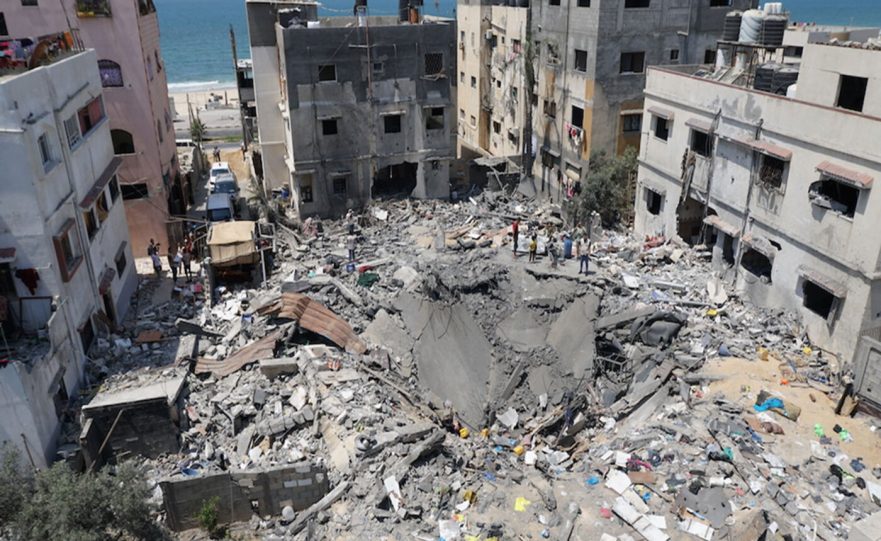by Yousef Aljamal
This following article by Palestinian rights activist, author, and translator Yousef Aljamal is crossposted from Politics Today.
On August 1, Israel launched another military campaign against the Gaza Strip, killing 46 Palestinians, 16 of whom were children, as young as 5 years old, and injuring 365 others. Israel claims that its military campaign only targeted Islamic Jihad, but facts on the ground speak of a different reality.
Since 1948, and especially with the occupation of the Gaza Strip and the West Bank in 1967, Israel has systematically targeted the Palestinian existence. Several massacres against the Gaza Strip took place at the hands of the Israeli army such as the Khan Yunis massacre on November 3, 1956, which claimed the lives of 275 Palestinians, while another massacre in Rafah killed 111 on the same date as the Suez Crisis broke out.
The excuse then was hunting Palestinian fighters during the crisis. More Palestinians were killed before and after as they attempted to return back to their towns and villages in what became Israel. They were called “infiltrators.”
The mere Palestinian existence after the Nakba is in itself a threat to Israel, as many of these Palestinians are refugees who reside a few miles away from what used to be their towns and villages and now under Israeli control. Israel has always sought to keep Palestinians at bay, by any means necessary, be it arrests, assassinations, massacres, or siege. Palestinians always have to be caged because, God forbid, if they are not, they might return back to what became the state of Israel, thus threatening its demographics.
An ongoing war
Understanding the Israeli policy of targeting the very existence of Palestinians translates into a dim reality on the ground where Israel’s non-stop war against the Palestinians continues unabated. This has included targeting the Palestinian presence in Lebanon, pressuring other countries to push the Palestinians out, and incessant surveillance of Palestinians putting them under a never-ending pressure. The Israeli understanding of suffocating the Palestinians stems from their belief that if Palestinians breathe enough, they may take action.
That’s why we read in the news every day that an Israeli raid targeted a Palestinian group or city. Israel’s propaganda machine, the Hasbara, promotes the claim that these attacks are individual, and they only target specific groups or cities. The truth is, in Israeli eyes, Palestinians are one, be they in the Gaza Strip, the West Bank, today’s Israel, or in exile. According to this Israeli understanding, Jenin is Gaza, Jerusalem is Hebron, and Nablus is Lod. The demolition of Palestinian houses in Israel or Jerusalem is also part of this Israeli approach.
For the Israeli policy to succeed, all of a sudden, after placing Palestinians under siege for more than 15 years, Israel decided to grant the Palestinians in the Gaza Strip thousands of work permits. The logic behind this is that Israel assumes that the Palestinians in Gaza will not risk losing these permits by engaging in a military confrontation with Tel Aviv, especially given that the majority don’t have an economic alternative and poverty has taken its toll on them.
Stories should count, Not numbers
In the midst of this Israeli madness, and as Israel’s killing machine continues targeting the Palestinians uninterruptedly, we should remember that Palestinians are not merely numbers and victims: Palestinians are a people with a history, families, memories, and dreams. The most recent Israeli offensives on Gaza, Jenin, and Nablus speak of these stories and dreams.
Alaa Qaddum, 5, had dreams that were cut short by an Israeli missile while playing with her friends to the east of Gaza. Her 7-year-old brother and father were injured too.
Ahmed Walid Ahmed al-Farram, 16, was killed by an Israeli air strike, according to Palestinian sources. His father was not able to bid him a final farewell as he couldn’t exit Israel, where he works, due to the closure of crossings leading to Gaza.
Another Israeli air strike on August 2 killed Yasser al-Nabahin and his three children, Muhammed (13), Dalia (13), and Nimer (9).
Palestinian elder Naa’ma Abuqaida, 62, lost her life as an Israeli airstrike targeted the car she was in on her way to her son’s wedding.
Palestinian Ashraf al-Qaisi, a father of eight, who works as a street vendor, agreed to let his house be demolished in order to make way for rescuers to reach his neighbors who were trapped under rubble. Rescuers couldn’t reach them because of the huge destruction Israeli air strikes caused.
When asked about where he plans to go with his family, al-Qaisi said, “To where people who have lost their houses go.”
The August 2022 escalation in Gaza reminds Palestinians of previous escalations they have experienced, during which they have lost their homes and loved ones. This is once again proof that there is no postwar or post-traumatic phase in Gaza, because wars and trauma are ongoing.

